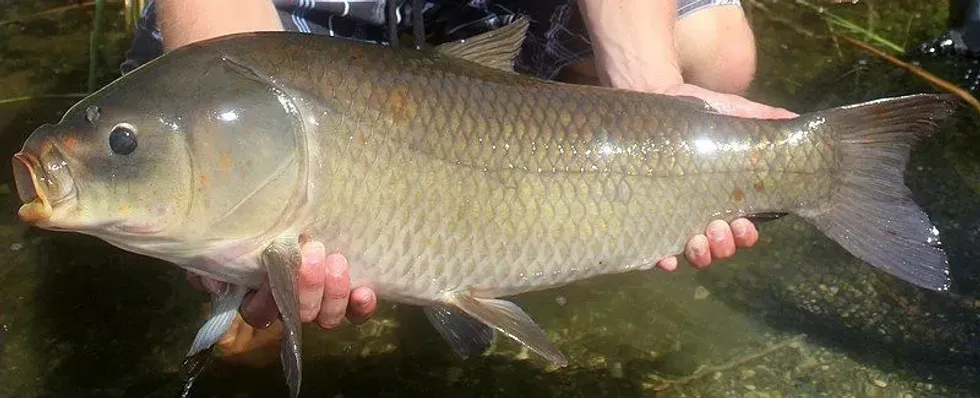The Bigmouth Buffalo (Ictiobus cyprinellus) belongs to the Catostomidae family which is also known as the sucker family.
The fish are primarily found in brownish-olive color and are also known by different names such as the brown buffalo, redmouth buffalo, gourd head, and many more. The species can easily be found in different countries of the North American continent such as the United States, Canada, and Mexico.
The fishes can easily be spotted in the famous rivers, and streams of the United States such as the Ohio River, Missouri River, Mississippi River, and Colorado River.
The species are quite large compared to other species, the bigmouth buffalo weighs around 37 lb (18 kg) and can go up to 74 lb (36 kg) while they are 3.5-4 ft (1.06-1.2 m) long. The fishes are omnivores and they prey on phytoplankton, chironomids, catfish, walleye, and northern pike.
The average lifespan of the bigmouth buffalo is quite a bit longer compared to other species and the oldest known fish is 112 years old.
Over the years, the population of the bigmouth buffalo fish has been impacted and the species has been listed as endangered in Pennsylvania, United States, due to the construction of dams, and human interference. Apart from this region, the population of the species is not of major concern.
Keep on reading to learn more interesting facts about the Bigmouth Buffalo fish. If you want to know more exciting information about different animals, check out koi facts and giant grouper facts.
Bigmouth Buffalo Fish Interesting Facts
What type of animal is a bigmouth buffalo fish?
A Bigmouth Buffalo fish is an omnivore fish generally found in different parts of North America prominently in the United States and Canada. The species is known for its longest lifespan.
What class of animal does a bigmouth buffalo fish belong to?
The bigmouth buffalo (Ictiobus cyprinellus) belongs to the family Catostomidae, also known as the suckers. They are of the Actinopterygii class and the Ictiobus genus. The species primarily prey on phytoplankton, chironomids, catfish, walleye, northern pike, and other fishes.
How many bigmouth buffalo fish are there in the world?
The exact population of the buffalo fishes is not known as of now but the fishes are quite common in the countries of North America such as the United States, Mexico, and Canada.
The fish can easily be spotted in the Mississippi River, and according to statistics, there were around five million buffalo fish in the Missouri River of Montana.
In other regions of the country as well, the numbers are satisfying.
Where does a bigmouth buffalo fish live?
The bigmouth buffalo is primarily found in several regions of the United States, Canada, and Mexico. A huge population is found in states such as Minnesota, and North Dakota. In states such as Texas, smallmouth buffalo fish are found.
What is a bigmouth buffalo fish's habitat?
The bigmouth buffalo fishes are found in the freshwater of great lakes, small and large rivers. The species is also of commercial importance and can easily be found at fish farms in North America.
Who does bigmouth buffalo fish live with?
As the bigmouth buffalo are quite large and are known as extreme predators, most of them live and hunt alone. Unlike other species, the buffalo fish do not live in groups or shoals.
How long does a bigmouth buffalo fish live?
The species of bigmouth buffalo belongs to the family of Catostomidae which is known for living the most. Also, the lifespan of bigmouth buffalo is the longest compared to every species. They can live a maximum of 112 years. But, the lifespan of smallmouth buffalo varies and they live shorter lives than bigmouth buffalo fishes.
How do they reproduce?
The bigmouth buffalo attains maturity between two and nine years of age, while other species attain maturity within three years. The fishes follow the system of polyandrous in which females spawn with more than two to three male partners at the same time.
During the breeding season, the male fishes develop nodules known as tubercles on their body while no such changes occur in the female body. They generally select a suitable site for spawning, prominently freshwater.
These fishes mate or spawn in a group in which only one female and several male fishes are involved. The male bigmouth buffalo fishes encircle while the female deposits the eggs.
A female bigmouth buffalo lays around 25,000 eggs at a time and it takes about one or two weeks for the hatching of eggs. Like other species of fish, no parental care is given to the eggs.
What is their conservation status?
The International Union for Conservation of Nature has listed the fish species in the Least Concern category as the population of the bigmouth buffalo is not a subject of disquiet.
But, over the years the numbers have fallen gradually due to several reasons such as the creation of dams, human involvement, and loss of habitat. Also, the fish species of bigmouth buffalo in Pennsylvania have been listed in the Endangered category as the species is highly affected by dams and fishing.
But, in other states of the United States, Mexico, and Canada, the population is not threatened or declining.
Bigmouth Buffalo Fish Fun Facts
What do bigmouth buffalo fish look like?
From Hudson Bay in Canada to the Mississippi in the United States, these rough fishes can be found quite easily in big lakes and rivers. The largest fish of the sucker family, the bigmouth buffalo are primarily found in brownish yellow color with dark-colored fins.
These fishes are different from the smallmouth buffalo as they have an elliptic body. As the name suggests the fishes are best known for their downward-facing huge mouth that helps them while catching any fish.
The species also has an anal fin, pelvic fin, anterior fin, and dorsal fin rays. Also, orange spots can be observed on adult fishes.

*Please note, this is an image of a carp fish which is a similar-looking species. If you have an image of a bigmouth buffalo fish, let us know at hello@kidadl.com
How cute are they?
The fishes are known for their huge downward-facing mouth and length. Their length could easily reach 3.5-4 ft (1.06-1.2 m). People generally consider them more dangerous than cute.
How do they communicate?
Like any other species, the bigmouth buffalo communicate the same way. Generally, fishes communicate through their touch and some studies also reveal that by the darkening of the skin, and sense of smell the buffalo fishes communicate.
How big is a bigmouth buffalo fish?
The bigmouth buffalo is the largest species in the entire family of Catostomidae. The weight of these fishes is around 37-74 lb (18-36 kg) while they are 3.5-4 ft (1.06-1.2 m) long.
The bigmouth buffalo fishes are six times the weight of the coho salmon fishes which are best known for their predatory skills. Also, the buffalo fishes are 10 times larger than the catfish.
How fast can a bigmouth buffalo fish swim?
Due to the weight of the body, the bigmouth buffalo generally moves slowly while swimming. They move at a speed of 0.67 mph (1.07 kph) while swimming. A young buffalo fish is believed to move at a higher velocity than adult fish.
How much does a bigmouth buffalo fish weigh?
The average weight of a bigmouth buffalo fish is 37-74 lb (18-36 kg). The species are considered the largest species of the sucker family.
What are the male and female names of the species?
There is no specific name given to the male and female species of bigmouth buffalo.
What would you call a baby bigmouth buffalo fish?
People often call a baby bigmouth buffalo an alevin. The term, alevin is used to refer to newly hatched babies or juveniles.
What do they eat?
The species is an omnivore as the fishes primarily prey on phytoplankton, chironomids, catfish, walleye, northern pike, aquatic insects, and several other fishes. For their food habits, the species is also regarded as the 'effective vacuum cleaner' for their exceptional use of gill rakers.
Are they poisonous?
No, the fishes do not contain venom that could be dangerous for humans but they are quite large and they have sharp teeth that can cause damage and injuries to humans. Also, they do not like human interference, but over the years no such incidents have taken place.
Would they make a good pet?
Generally, the species belong to the wild habitat, and it is not recommended to pet a bigmouth buffalo for several reasons. Firstly, the eating habits of the fish are very different from other species, also your pond or aquarium is always different from their habitat.
They primarily live either in the freshwater of a river, or lakes and need a large area for swimming. It would become very hard for humans to handle such a dangerous species as their pet.
Did you know...
Several records have been made by people while fishing. A few years back, a small guy named Noah made a world record by catching a 49.5 in (126 cm) bigmouth buffalo fish during fishing.
The National Fresh Water Fishing Hall of Fame declared it a world record.
No one had ever caught such a huge fish in the history of fishing. Another man caught a 45 in (110 cm) buffalo fish while fishing and it took more than 40 minutes to reel the fish, the Tennessee Wildlife Resources Agency stated.
We all know that the oldest bigmouth buffalo fish recorded fish was 112 years old but a recent study revealed that a huge population of fishes found in Minnesota is more than 80 years old.
People eat the meat of the bigmouth buffalo fish as the meat is quite soft and tender to eat and adds more flavor if cooked properly. Also, they are large and have big bones that help to eat the meat quite easily.
Just like carp meat, buffalo fishes are good for your health as they have low-fat content. Several recipes are available online, so go and start making your fish!
Is a buffalo fish a carp?
Oily freshwater fishes are primarily known as carp that are majorly found in countries of Asia and Europe. Some are also found in several regions of the African continent, the United States, and Australia. People often get confused between carp and bigmouth buffalo fishes as the anglers both are considered rough fishes but several characteristics differentiate between both species.
The latter is primarily found in North American countries and is brownish-yellow in color while the carp fishes are yellow. The buffalo fish has a vacuum-liked mouth compared to the carp fish. Also, buffalo fishes have dark blue fins, different from carp fishes. Thus they are not the same.
Is buffalo fish a bottom feeder?
The bottom feeder fishes are those who prey on the aquatic animals that are found at the bottom of the rivers and oceans. The word benthos is often used by experts to refer to the bottom feeders. Like other species of the sucker family, the buffalo fish is a bottom feeder.
They use gill rakers to eat zooplankton. The young fishes primarily prey on copepods, algae, and different insect larvae. The species is also known as the effective vacuum cleaner.
Here at Kidadl, we have carefully created lots of interesting family-friendly animal facts for everyone to discover! Learn more about some other fishes including triggerfish or pallid sturgeon.
You can even occupy yourself at home by drawing one on our Buffalo Fish coloring pages.










